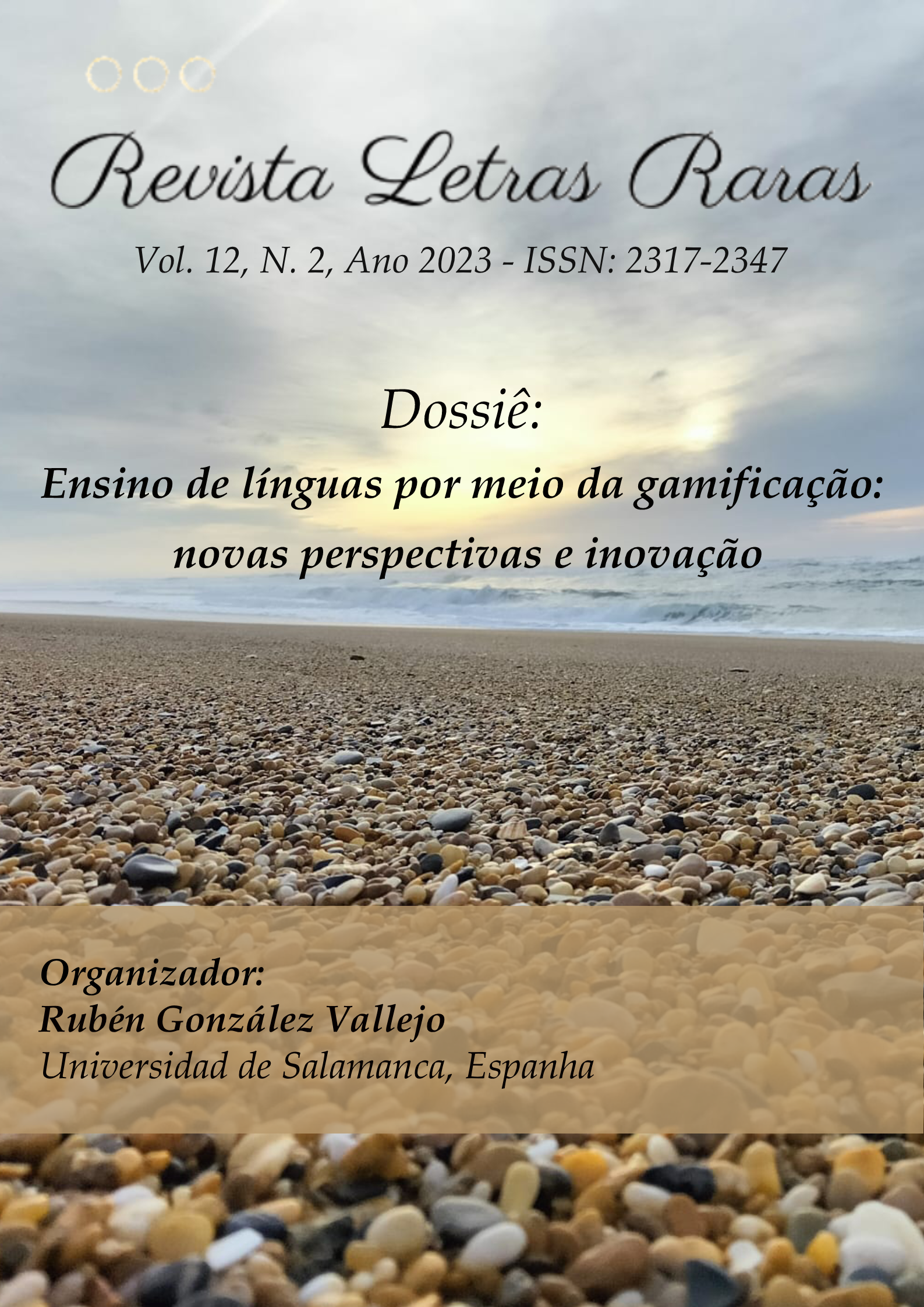Creativity and Language Learning through Digital Narratives, Didactic Audiovisual Translation and ‘The Sims’
DOI:
https://doi.org/10.5281/zenodo.8299800Palavras-chave:
Educational technologies, Audiovisual Translation, Language teaching, Gamification, Video gamesResumo
In a digitalized world where multimodality is part of daily routine, it is of great interest to explore the didactic possibilities of digital narratives. In this regard, based on a student-centred paradigm, this pedagogical proposal has been designed with the aim of enabling students to create their own digital narratives in a second/foreign language (L2/FL) by combining two Didactic Audiovisual Translation modes: subtitling and dubbing. To create the audiovisual materials, it is proposed that students make use of the video game "The Sims" due to its availability and its potential to simulate real-life situations. It is expected that the motivation derived from producing their own audiovisual materials, combined with exposure to the L2/FL, will enable students to acquire the language while fostering their creativity in virtual environments.
Downloads
Referências
AMANIYAN, S.; VAHIDEH, P.; MOJTABA, V. Comparison of the Conceptual Map and Traditional Lecture Methods on Students’ Learning Based on the VARK Learning Style Model: A Randomized Controlled Trial. SAGE Open Nursing, v. 6, P. 1 – 16, 2020.
ARANDA, D. Más razones y menos prejuicios con los videojuegos. COMeIN, n. 72, p. 1-4, 2017.
ÁVILA-CABRERA, J. J. Improving oral production skills in the Business English class through creative dubbing. ESP Today. Journal of English for Specific Purposes at Tertiary Level, v. 10, n. 1, p. 99–122, 2022. Disponível em: <https://doi.org/10.18485/esptoday.2022.10.1.5>.
BAUSELLS-ESPÍN, A. Audio Description as a Pedagogical Tool in the Foreign Language Classroom. Journal of Audiovisual Translation, v. 5, n. 2, p. 152 – 175, 21 dez. 2022.
BELDA-MEDINA, J.; CALVO-FERRER, J. R. Integrating augmented reality in language learning: pre-service teachers’ digital competence and attitudes through the TPACK framework. Education and Information Technologies, v. 27, n. 9, p. 12123 –12146, 2022.
BENATOV, J.; BERGER, R.; TADMOR, C. T. Gaming for peace: Virtual contact through cooperative video gaming increases children’s intergroup tolerance in the context of the Israeli–Palestinian conflict. Journal of Experimental Social Psychology, v. 92, p. 1 – 14, 2021.
BOLAÑOS-GARCÍA-ESCRIBANO, A.; NAVARRETE, M. An action-oriented approach to didactic dubbing in foreign language education: Students as producers. XLinguae, v. 5, n. 2, p. 103–120, 2022.
BURGESS, M. C. R.; DILL, K.; STERMER, S.; BURGUESS, S.; BROWN, B. Playing with prejudice: The prevalence and consequences of racial stereotypes in video games. Media Psychology, v. 14, n. 3, p. 283 – 311, 2011.
CALVO FERRER, J. R.; BELDA-MEDINA, J. R. Análisis de la satisfacción del alumnado de L2 con respecto a la adquisición de terminología especializada por medio de videojuegos: estudio de caso. Porta Linguarum Revista Interuniversitaria de Didáctica de las Lenguas Extranjeras, v. 44, n. 1, p. 179 – 190, 2015.
CALVO-FERRER, J. R. Educational games as stand-alone learning tools and their motivational effect on L2 vocabulary acquisition and perceived learning gains. British Journal of Educational Technology, v. 48, n. 2, p. 264 – 278, 2017.
CALVO-FERRER, J. R. Effectiveness of type of feedback and frequency on digital game-based L2 vocabulary acquisition. International Journal of Game-Based Learning, v. 11, n. 3, p. 38 – 55, 2021.
CANALES HERNÁNDEZ, M. DEL P. Análisis descriptivo de la mediación lingüística: revisión actualizada del cuarto modo de comunicación. Epos: Revista de filología, n. 38, p. 3–29, 19 dez. 2022. Disponível em: <https://revistas.uned.es/index.php/EPOS/article/view/36360>.
CHAUME, F. Audiovisual translation: Dubbing. New York: Routledge, 2012.
CHAUME, FREDERIC. The turn of audiovisual translation. Translation Spaces, v. 2, p. 105 – 123, 2013.
DI CARLO, A. Comprehensible Input Through the Practical Application of Video-Texts in Second Language Acquisition. Italica, v. 71, n. 4, p. 465 – 483,1994.
DÍAZ CINTAS, J. El subtitulado como técnica docente. Vida Hispánica, v. 12, p. 10–14, 1995.
DÍAZ-CINTAS, J. La Traducción Audiovisual: el subtitulado. [S.l.]: Almar, 2001.
ELLIS, R. Principles of instructed language learning. System, v. 33, n. 2, 2005.
HUERTAS-ABRIL, C. A.; GÓMEZ-PARRA, M. E. International approaches to bridging the language gap. IGI-Global, 2019.
INCALCATERRA MCLOUGHLIN, L.; LERTOLA, J. Learn through subtitling: Subtitling as an aid to language learning. In: INCALCATERRA MCLOUGHLIN, L.; BISCIO, M.; NÍ MHAINNÍN, M. Á. (Org.). Audiovisual Translation Subtitles and Subtitling. Theory and Practice. Bern: Perter Lang, 2011. p. 243–263.
KRASHEN, S. We Acquire Vocabulary and Spelling by Reading: Additional Evidence for the Input Hypothesis. The Modern Language Journal, v. 73, n. 4, 1989.
LERTOLA, J.; MARIOTTI, C. Reverse Dubbing and Subtitling: Raising Pragmatic Awareness in Italian ESL Learners. JoSTrans-The Journal of Specialised Translation, v. 28, p. 103–121, 2017. Disponível em: <https://www.jostrans.org/issue28/art_lertola.pdf>.
LORENSET, C. C.; TUMOLO, C. H. S. Vocabulary Acquisition in English as a Foreign Language: Digital Gameplaying The Sims. Revista Linguagem & Ensino, v. 22, n. 4, p. 1002 – 1019, 2019.
MANGIRON, C. Found in Translation: Evolving Approaches for the Localization of Japanese Video Games. Arts, v. 10, n. 1, p. 1 – 18, 2021.
MANGIRON, C. Game on! Burning issues in game localisation. Journal of Audiovisual Translation, v. 1, n. 1, p. 122 – 138, 2018.
MANGIRON, C. Games without borders: The cultural dimension of game localisation. Hermeneus, v. 18, p. 187 – 208, 2016.
NAVARRETE, M. The use of audio description in foreign language education. Translation and Translanguaging in Multilingual Contexts, v. 4, n. 1, p. 129–150, 2018.
OGEA-POZO, M. La traducción audiovisual desde una dimensión interdisciplinar y didáctica. Madrid: Sindéresis, 2020.
OGEA-POZO, M. Subtitulado del género documental: de la traducción audiovisual a la traducción especializada. Madrid: Sindéresis, 2018.
OGEA-POZO, M. Una propuesta didáctica para la traducción y locución de voces superpuestas. In: BOTELLA-TEJERA, C.; AGULLÓ-GARCÍA, B. (Org.). Mujeres en la Traducción Audiovisual II: Nuevas tendencias y futuro en la investigación y la profesión. Madrid: Sindéresis, 2022. p. 51–71.
OGEA-POZO, M. DEL M. Into The Shoes of Visually Impaired Viewers: a Pedagogical Experiment to Improve Audio Description and English Language Skills. International Journal for 21st Century Education, v. 9, n. 1, p. 73–87, 2022. Disponível em: <https://www.uco.es/ucopress/ojs/index.php/ij21ce/article/view/15169/13684>.
PALION-MUSIOL, A. Audio description and its application in Spanish language glottodidactics. In: LENKAITIS, C. A.; HILIKER, S. M. (Org.). Engaging teacher candidates and language learners with authentic practice. Hershey PA, EEUU: IGI Global, 2019. p. 206–226.
PLAZA LARA, C.; FERNÁNDEZ COSTALES, A. Enhancing communicative competence and translation skills through active subtitling: a model for pilot testing didactic Audiovisual Translation (AVT). Revista de Lenguas para Fines Específicos, n. 28.2, p. 16–31, 12 dez. 2022.
RANALLI, J. Learning English with the Sims: Exploiting authentic computer simulation games for L2 learning. Computer Assisted Language Learning, v. 21, n. 5, 2008.
SAMPEDRO REQUENA, B. E.; MUÑOZ, J. M.; VEGA, E. El videojuego digital como mediador del aprendizaje en la etapa de Educación Infantil. Educar, v. 53, n. 1, 2017.
SAMPEDRO REQUENA, B.E.; MCMULLIN, K. J. Videogames for the educative inclusion | Videojuegos para la inclusión educativa. Digital Education Review, n. 27, p. 122 – 137, 2015.
SAMPEDRO REQUENA, B. E. Las TIC y la educación social en el siglo XXI. EDMETIC, v. 5, n. 1, p. 8 – 24, 2016.
SÁNCHEZ-REQUENA, A. Audiovisual Translation in Teaching Foreign Languages: Contributions of Dubbing to Develop Fluency and Pronunciation in Spontaneous Conversations. Porta Linguarum, v. 26, p. 9–21, 2016.
SÁNCHEZ-REQUENA, A. Intralingual Dubbing as a Tool for Developing Speaking Skills. (J. T. Noa Incalcaterra McLoughlin Laura; Lertola, Org.)Translation And Translanguaging in Multilingual Contexts. Special issue of Translation and Translanguaging in Multilingual Contexts. Audiovisual Translation in Applied Linguistics: Beyond Case Studies. [S.l.]: John Benjamins Publishing Company, 2018
SÁNCHEZ-REQUENA, A. Intralingual dubbing as a tool for developing speaking skills. In: INCALCATERRA MCLOUGHLIN, LAURA; LERTOLA, JENNIFER; TALAVÁN, N. (Org.). Audiovisual Translation in Applied Linguistics: Educational Perspectives. Amsterdam: John Benjamins, 2020. p. 103–129.
TALAVÁN, N. Subtitling as a Task and Subtitles as Support: Pedagogical Applications. In: DÍAZ CINTAS, J.; MATAMALA, A.; NEVES, J. (Org.). New Insights into Audiovisual Translation and Media Accessibility. New York: Rodopi, 2010. p. 285–299. Disponível em: <http://www.nuigalway.ie/sub2learn/downloads/talavn_2010_subtiling_as_a_task_and_subtitles_as_a_support.pdf>.
TALAVÁN, NOA. Las voces superpuestas: Fundamentos y aplicaciones didácticas. (C. Botella & B. Agulló, Org.) Mujeres en la traducción audiovisual. Madrid: Sinderesis, 2021
TALAVÁN, NOA; ÁVILA-CABRERA, J. J. Creating collaborative subtitling communities to increase access to audiovisual materials in academia. The Interpreter and Translator Trainer, v. 15, n. 1, p. 118–135, 2 jan. 2021.
TALAVÁN, NOA; ÁVILA-CABRERA, J. J. First insights into the combination of dubbing and subtitling as L2 didactic tools. In: GAMBIER, Y.; CAIMI, A.; MARIOTTI, C. (Org.). Subtitles and Language Learning. Bern: Peter Lang, 2015a. p. 149–172.
TALAVÁN, NOA; ÁVILA-CABRERA, J. J. First insights into the combination of dubbing and subtitling as L2 didactic tools. In: GAMBIER, Y; CAIMI, A.; MARIOTTI, C. (Org.). Subtitles and Language Learning. [S.l.]: Peter Lang, 2015b. p. 149–172.
TALAVÁN, NOA; COSTAL, T. iDub - The potential of intralingual dubbing in foreign language learning: How to assess the task. Language Value, v. 9, n. 1, p. 62–88, 2017.
TALAVÁN, NOA; LERTOLA, J. Active audio description to promote speaking skills in online environments. Sintagma, Revista de Lingüística, n. 28, p. 59–74, 2016. Disponível em: <https://doi.org/10.21001/sintagma.2016.28.04>. Acesso em: 17 abr. 2022.
TALAVÁN, NOA; LERTOLA, J. Audiovisual Translation as a Didactic Resource in Foreign Language Education. A Methodological Proposal. Encuentro, v. 30, p. 23–39, 2022.
TALAVÁN, NOA; LERTOLA, J.; IBÁÑEZ, A. Audio description and subtitling for the deaf and hard of hearing Media accessibility in foreign language learning. Translation and Translanguaging in Multilingual Contexts, 2022.
TALAVÁN, NOA; RODRÍGUEZ-ARANCÓN, P. The use of interlingual subtitling to improve listening comprehension skills in advanced EFL students. In: GARZELLI, B.; BALDO, M. (Org.). Subtitling and Intercultural Communication. European Languages and beyond. Pisa: InterLinguistica ETS, 2014a. p. 273–288.
TALAVÁN, NOA; RODRÍGUEZ-ARANCÓN, P. The use of reverse subtitling as an online collaborative language learning tool. Interpreter and Translator Trainer, v. 8, n. 1, p. 84–101, 2014b.
TALAVÁN, NOA; RODRÍGUEZ-ARANCÓN, P. Voice-over to improve oral production skills. In: SANDERSON, J. D.; BOTELLA-TEJERA, C. (Org.). Focusing on Audiovisual Translation Research. [S.l.]: PUV, Publicacions Universitat de Valencia, 2018. p. 211–229.
TALAVÁN, NOA; TINEDO-RODRÍGUEZ, A. J. Audiodescripción (AD) y Subtitulado para personas Sordas (SpS) en la clase de lenguas: fundamentos de Accesibilidad Audiovisual Didáctica (ACAD). In: VARELA-SALINAS, M. J.; PLAZA-LARA, C. (Org.). . Aproximaciones teóricos y prácticas a la accesibilidad desde la traducción y la interpretación. [en prensa]: Comares, 2023a.
TALAVÁN, NOA; TINEDO-RODRÍGUEZ, A. J. Una mirada transdisciplinar a la Traducción Audiovisual Didáctica. Hikma, v. 22, n. 1, p. 143–166, 31 maio 2023b.
TAN, W.; SUPIAN, N.; CHEAH, K. S. Game-Based Learning in Improving English Vocabulary and Detecting Metacognitive Awareness Among English for Specific Purposes Undergraduates. Advances in Social Science, Education and Humanities research, v. 629, p. 135 – 140, 2022.
TINEDO-RODRÍGUEZ, A. J.; FRUMUSELU, A. SDH as an AVT Pedagogical Tool: Promoting L2 Integrated Language Skills, Interculturality and EDI. Translation and Translanguaging in Multilingual Contexts, v. (in press), 2023.
VANDERPLANK, R. The value of teletext sub-titles in language learning. ELT Journal, v. 42, n. 4, p. 272–281, 1988. Disponível em: <https://academic.oup.com/eltj/article-abstract/42/4/272/484447 >.
VERMEULEN, A.; ESCOBAR, L. Audiovisual translation (dubbing and audio description) as a didactic tool to promote foreign language learning: The case of Spanish clitic pronouns. Translation and Translanguaging in Multilingual Contexts, v. 7, n. 1, p. 86–105, 2021.
VERMEULEN, A.; ESCOBAR-ÁLVAREZ, M. Á. Audiovisual translation (dubbing and audio description) as a didactic tool to promote foreign language learning. Translation and Translanguaging in Multilingual Contexts, v. 7, n. 1, p. 86–105, 19 mar. 2021. Disponível em: <http://www.jbe-platform.com/content/journals/10.1075/ttmc.00060.ver>. Acesso em: 15 jan. 2023.
VERMEULEN, A.; IBÁÑEZ MORENO, A. Audio description as a tool to promote intercultural competence. In: DECONINCK, J. et al. (Org.). Towards Transcultural Awareness in Translation Pedagogy. Wien: LIT Verlag, 2017. p. 133–153.
ZYZIK, G. Winning against prejudice. Video games in shaping attitudes toward social exclusion. Dziennikarstwo i Media, v. 14, p. 81-88, 2021.
Downloads
Publicado
Como Citar
Edição
Seção
Licença
Copyright (c) 2023 Revista Letras Raras

Este trabalho está licenciado sob uma licença Creative Commons Attribution-NonCommercial 4.0 International License.







